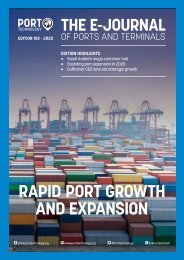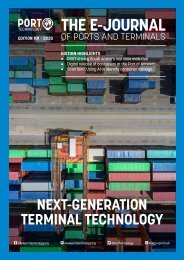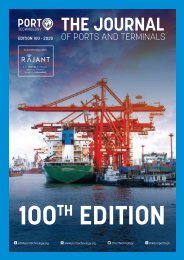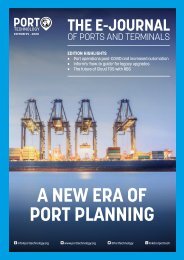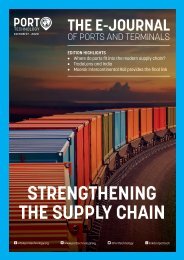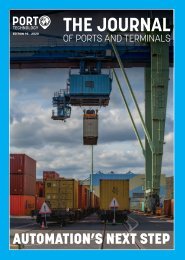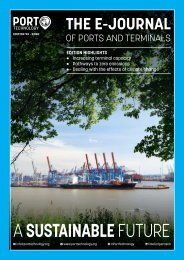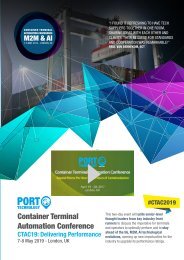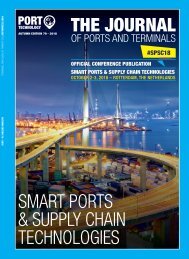Automation Innovations
As we enter the second half of 2020 the full effects of the COVID-19 pandemic are now being realised across the global economy and the port industry. For many, cargo throughput has been significantly decreasing compared with the same period for 2019. For example, the Port of Los Angeles handled 581,665 TEUs in May, a 29.8
As we enter the second half of 2020 the full effects of the COVID-19 pandemic are now being realised across the global economy and the port industry. For many, cargo throughput has been significantly decreasing compared with the same period for 2019.
For example, the Port of Los Angeles handled 581,665 TEUs in May, a 29.8
You also want an ePaper? Increase the reach of your titles
YUMPU automatically turns print PDFs into web optimized ePapers that Google loves.
AUTOMATION INNOVATION<br />
This will already significantly increase<br />
the crane span of the crane and as well the<br />
crane lifting height.<br />
The benefit of this operation is mainly<br />
the reduction of chassis on the terminal<br />
and the required chassis parking area.<br />
Utilising a perpendicular parking underneath<br />
the cantilever of the gantry crane<br />
will significantly densify the chassis staging<br />
capacity.<br />
Further as moving containers from the<br />
container stack to the rail car, it is required<br />
that the crane is capable of moving with a<br />
considerable speed (up to 400 ft./min) in<br />
the direction of the rail track. This as the<br />
rail car is most likely not next to the container<br />
in the container stack and therefore<br />
the crane needs to bring the container from<br />
the stack to the railcar.<br />
What we see as per today is mainly using<br />
Rail mounted Gantry Cranes (RMG) for this<br />
kind of operation.<br />
Intermodal terminals in North America<br />
having much bigger train length (up to<br />
16,000 ft or 4,877m) and longer loading<br />
tracks (between 3,000ft/915m and<br />
6,000ft/1,829m) compared to Europe.<br />
Given this consideration it also means<br />
that the track length served by an individual<br />
lifting crane needs to be longer as well. Due<br />
to this RMGs are mainly used in high capacity<br />
Intermodal Yards.<br />
NEW CAPABILITY OF THE FREERIDER RTG<br />
As described above certain capabilities of<br />
traditional RTGs restricting the utilisation of<br />
a container stack in an intermodal application.<br />
Therefore, stability of the load on the<br />
crane (anti sway) and the capability of<br />
traveling in gantry direction at a considerable<br />
speed (up to 400 ft/min) is essential<br />
for such an operation. The gantry speed is<br />
required as the time within a moved used<br />
for gantry travel is the major factor influencing<br />
cycle time and therefore terminal<br />
productivity.<br />
Given the new capabilities of the Freerider<br />
RTG, stacking operation with an RTG becomes<br />
feasible. This even as the RTG crane<br />
has to travel an extended range in order to<br />
bring a container from the container stack<br />
to the rail car. Therefore, travelling with a<br />
loaded container, using high speed, is essential<br />
to this operation.<br />
Again, traveling time is one the main<br />
factors influencing terminal productivity.<br />
Further due to the design of the Freerider,<br />
much bigger span can be utilised in order<br />
to accommodate a container stack underneath<br />
the crane.<br />
Container stack operations can be optimized<br />
in shuffling containers expected to be<br />
loaded soon. This moving a container from a<br />
lower tier to a more accessible storage position<br />
is called Housekeeping. The Freerider<br />
provides automation capabilities, doing this<br />
Housekeeping automated during low terminal<br />
utilisation time. Further the automation<br />
features can be extended to remote operation<br />
or as far as to a nearly fully automated<br />
intermodal yard operation. Therefore, the<br />
capabilities of the Freerider RTG is at least<br />
keeping up with the automation features an<br />
automated RMG is providing today.<br />
HYBRID TERMINAL OPERATION<br />
The operation of a terminal based on mixed<br />
ground stacking in combination with a chassis<br />
operation is also called hybrid operation.<br />
In a hybrid operation containers which are<br />
destine to leave the terminal within a short<br />
time are loaded onto chassis. Containers<br />
which are predicted to stay longer at the terminal<br />
are being moved to the ground stack.<br />
Such a hybrid operation reduces significantly<br />
the space required in order to park<br />
loaded chassis and as well the movement of<br />
chassis by using Terminal Tractors.<br />
Another important component of such<br />
a hybrid operation is the predictability of<br />
container pickup and delivery. The more<br />
accurate the prediction on the truck arrival<br />
is, the more preparation work on the container<br />
stack can be done. This means low<br />
gate traffic hours can be used to re shuffle<br />
containers in the stack.<br />
The ultimate saving in cost are the reduced<br />
footprint at a given terminal capacity<br />
as a capital expense, or the ability to<br />
increase terminal capacity at an existing<br />
footprint.<br />
Further reducing equipment, used to<br />
stage chassis at the parking area, will also<br />
significantly reduce operational costs. Stacking<br />
capability means also offering container<br />
storage as a paid service to the customer.<br />
Even in such a hybrid operation re shuffling<br />
of containers is required, this can be<br />
done during low traffic hours. Preparing for<br />
upcoming predicted truck traffic will spread<br />
out the workload within the terminal more<br />
evenly. Having containers positioned at<br />
their optimum loading position will reduce<br />
truck dwell time.<br />
SUMMARY POINTS<br />
• With the capability of the Freerider RTG<br />
a ground stacking operation at intermodal<br />
terminals is feasible.<br />
• Travel speed with a loaded crane is essential<br />
for productivity.<br />
• <strong>Automation</strong> is feasible with the Freerider<br />
RTG.<br />
• Load stability is needed for handling the<br />
container stack.<br />
• Substantial saving in cost are the reduced<br />
footprint, due to the Hybrid operation,<br />
at a given terminal size.<br />
• Reducing equipment, as less Terminal<br />
Tractors are benefiting operational<br />
costs.<br />
• RTGs are an alternative solution at lower<br />
capacity terminals.<br />
• RTGs offering advantages in brown field<br />
installations in reducing civil work.<br />
ABOUT THE AUTHOR<br />
Walter Leiler has been with Kuenz for<br />
more than 30 years. From 2001 until<br />
2004 Leiler was based in Raleigh, NC,<br />
and was involved in establishing the<br />
branch office there for the company. He<br />
returned to Raleigh in 2019 to cover the<br />
North American crane market. He has<br />
been in sales and project management<br />
for 20 year and was project manager for<br />
automation projects including CTA Hamburg,<br />
GCT Vancouver and CSX Transportation.<br />
ABOUT THE ORGANIZATION<br />
Kuenz was founded in 1932 by Hans<br />
Kuenz who succeeded in creating a significant<br />
and successful mechanical engineering<br />
company in a very short period<br />
of time. The company started out manufacturing<br />
tower construction cranes, the<br />
focus later shifted towards manufacturing<br />
container cranes, followed by hydro<br />
power equipment. Kuenz is one of the<br />
oldest and most prestigious mechanical<br />
engineering companies in the western<br />
region of Austria.<br />
ENQUIRIES<br />
Email: walter.leiler@kuenz.com<br />
Phone: +1 984 255 1009<br />
Cell: +1 919 397 4048<br />
EDITION 98 17




